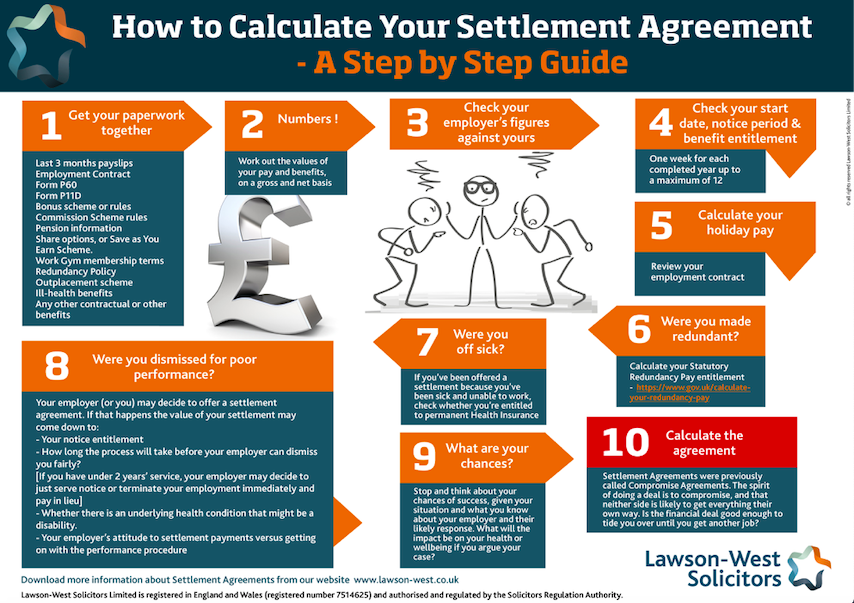10-Step Guide for Employees Calculating Employment Settlement Agreements
If you have been offered a settlement agreement (formerly known as a ‘compromise agreement’) or if you are on the verge of approaching settlement agreement negotiations with your employer, you may be wondering what steps you can take to reach the best possible outcome for you.
If you’re not happy with your settlement agreement, we can help give you strategic advice on your options in order to strengthen your position and negotiate favourable terms. By following this 10 Step Guide you can calculate how much your settlement should be and what needs to be considered.
10-Step Guide for Employees Calculating Employment Settlement Agreements
Step 1 – Get your paperwork together
Firstly collate your paperwork so you can calculate the value of your settlement. Use the following as a checklist for what you need to look at:
-
Last 3 months payslips.
-
Contract of Employment
-
Form P60 (this is the tax summary your employer gives you at the end of each tax year in April).
-
Form P11D – this will show the taxable value of any contractual benefits you enjoy.
-
Information or Policy about the Bonus scheme or rules.
-
Information or Policy about the Commission Scheme rules.
-
Pension information documents.
-
Share options, or Save as You Earn Scheme documents.
-
Information or Policy about the Work Gym membership terms.
-
Redundancy Policy – e.g. can you claim a ‘enhanced redundancy’ payment?.
-
Information or Policy about the Outplacement scheme – e.g. does employer provide free or subsidised career support to help you find your next role?
-
Information or Policy about the Ill-health benefits – e.g. have you been on sick leave which has prompted this settlement agreement from your employer?
-
Any other contractual or other benefits?
Step 2 - Numbers!
Work out the value of your pay and benefits, on a gross and net basis.
Step 3 – Check your employer’s figures against yours
This is to see if the figures used in the settlement agreement match up to what your annual salary is. This will help you work out your employer has calculated your settlement agreement package.
Step 4 - Check your start date, notice period, and benefit entitlements
Your written contract of employment (if you were given one) will tell you what your notice period is.
If you were never given a contract of employment, then your notice period is as per your statutory minimum entitlement, which is: one week for each completed year up to a maximum of 12 weeks.
Some employers may be mistaken about your start date, therefore check your start date and work out your notice entitlement. Then check your settlement agreement to see if it confirms you are being paid your full notice period.
If you are being subjected to allegations of gross misconduct, then your employer may argue that they are able to dismiss you without notice and therefore do not need to pay you for your notice period. However in these circumstances we would advise that there may not be any incentive for you to enter into a settlement agreement. This of course depends on the circumstances therefore speak to our expert settlement agreement solicitors who can help you better understand the complexities and practical implications of the terms on offer. We can advise you on any potential risks and pitfalls.
Your employer may instead ask you to work your notice but if you’d prefer to leave sooner, we can help you negotiate you getting this paid lieu of your notice instead. This will mean any other benefits you enjoy will end sooner.
Therefore calculate how much your benefits amount to by looking at your most recent Form P11D, or check with payroll. Anything like, private health cover, gym membership, car allowances, discount vouchers and pension contributions need to be considered.
A part of your negotiations should be to see if you can ensure these benefits can be continued or the value of these are paid to you for the duration of your notice period.
Step 5 - Calculate your holiday pay
Look at your contract of employment to find out what your holiday entitlement is as you are entitled to be paid any holidays you have not taken up to the date of your employment ending.
Most people are aware that they are entitled to 5.6 weeks’ or 28 days annual leave under the Working Time Regulations 1998 (WTR). This is reduced for part-time workers, although it can still be expressed as 5.6 weeks. For example, if you worked three days per week, you would be entitled to 16.8 days’ annual leave (3 x 5.6). Your employer can choose to round up that figure but they cannot round it down, but you may be contractually entitled to more than this, so check your employment contract.
Step 6 – Were you made redundant?
If your employer has given you a settlement agreement due to a redundancy situation then, if have two or more years’ service, you are entitled to a minimum redundancy payment. The statutory redundancy payment is payable in addition to your notice and holiday entitlement.
The amount you are entitled to depends on your length of service (in complete years), your age and weekly gross pay. Use the online Government Redundancy Calculator to work this out, then see if the settlement agreement on offer matches or exceeds this.
However if your employer has an enhanced redundancy scheme in place you should be able negotiate this to be used for your settlement agreement instead. Find the policy your employer has about this and work out your enhanced redundancy amount but using formula found within the policy.
Step 7 – Were you off sick?
If you’ve been offered a settlement because you’ve been sick and unable to work, check whether you are entitled to permanent Health Insurance. This is normally a form of insurance or part of an employee’s benefit package and the terms of such policies will vary but the purpose is to provide you with an income if you are unable and unfit to do any work.
Please note that often permanent Health Insurance policies tend to end once an employee’s employment is terminated but the payments may be higher under the policy if you qualify. Therefore seeking both a termination payment and permanent Health Insurance under a settlement agreement will be something your employer would have to agree too.
Step 8 – Were you dismissed for poor performance?
You or your employer may decide to proceed with a settlement agreement instead of dealing with e.g. disciplinaries, performance management or even a performance improvement plan. If this happens then often the settlement agreement on offer will be about your notice pay, holiday entitlement and potentially loss of earnings for a certain period.
If a employer wanted to dismiss you for poor performance, then unless you have been found guilty of gross misconduct, you will still be entitled to your contractual notice pay. If you have under two years’ service, your employer may just serve notice or terminate your employment immediately and pay in lieu the notice pay. Often employers will do this to ensure the employee if prevented from gaining two years’ employee service which is a requisite for bringing a claim for ordinary unfair dismissal.
However if you have more than two years’ employee service, your employer will need to follow the correct procedures if they want to avoid facing a unfair dismissal claim. This requires you being given reasonable time to e.g. improve your performance, issue warnings first then led to a final warning, before dismissing you. This could take several months which can be avoided if the settlement agreement payments are enough to warrant you agreeing to end your employment first by mutual agreement.
If you suffer with a health condition that might amount to being a disability and are being subjected to performance plans or even warnings of being dismissal, you may have a potential claim for disability discrimination. If there are ‘reasonable adjustments’ that can be made by your employer, but they simply do not want to have to deal with this then your settlement agreement payment could be increased to provide you with the incentive to agree to the settlement.
Step 9 – What are your chances?
Stop and think about your chances of success, given your situation and what you know about your employer and their likely response. What will the impact be on your health or wellbeing if you argue your case?
If your employer is known for offering settlement agreement packages, then a early conversation may be negotiated if you approach them first about this. however, employers are unlikely to overpay and some may prefer to performance manage you and see what happens.
Taking a realistic approach can therefore maximise chances of getting the best settlement from your employer. If you try to get a settlement that is higher or even similar to the outcome you would want to receive from an Employment Tribunal, this is unlikely to help negotiations. Taking this approach will most likely result in your employer being happy to defend any claim you make against them as it may be less expensive for them to do this instead.
Instead most employers look to achieve potential savings as part of the settlement they give to you. We can help you in negotiations by highlighting to your employer, how they will be saving time, legal costs, reputational damage or having to pay increased compensation if you were awarded this by a Judge, in comparison to what you ask for now in a settlement agreement.
Step 10 – Calculate the agreement
Settlement Agreements were previously called Compromise Agreements, as the whole purpose of these are to settle claims and reach a compromise. Neither side is going to everything they want; for the employee, there can be non-financial benefits to doing a deal, such as being released from post-termination restrictions, that might mean the settlement agreement monetary value is less.
You could even lose the entire settlement agreement on offer if you fight too hard, which is rare but always a possibility. You may annoy your employer to the point where negotiations cannot continue. If you would want to leave on amicable terms, then trying to get everything you initially propose could damage the relationship with colleagues e.g. if you worked with the same individuals elsewhere in the future.
Therefore when considering the financial and non-financial considerations, is the settlement agreement a deal which is good enough to tide you over until you get another job? An agreed employee reference may be more important for you in the future.
How can we help?
We hope you found this 10 Step Guide on settlement agreements helpful. At Lawson-West our expert settlement agreement solicitors can help provide honest advice as well as pragmatic support through each step of the settlement agreement process. We can help protect your interests and your position during the negotiation to ensure you understand the practical implications of the settlement agreement terms.
Our solicitors are available to provide the appropriate advice and guidance in relation to any aspect of settlement agreements or employment law.
Please contact us on Tel: 0116 212 1000 or 01858 445 480, alternatively complete the free Contact Us form here and we will get in touch as soon as possible.
See our website pages on Settlement Agreements:
What is a Settlement Agreement?
What is the Settlement Agreement process?
10-Step Guide for Employees Calculating Employment Settlement Agreements
What to expect in a Settlement Agreement?
Implications of Restrictive Covenants


